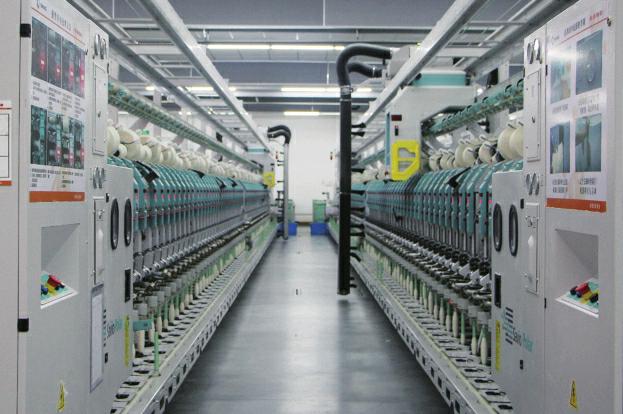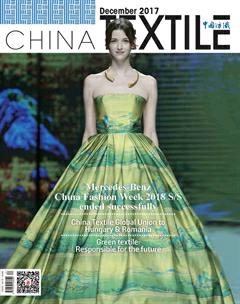“Dual control”for quality-critical yarns
One of the top ten spinning mills in China, Texhong Group has grown steadily since its establishment in 1997, building a reputation for high value-added products in challenging market sectors such as core-spun yarns, as well as grey fabrics and fashion materials. The groups strong quality ethic is the basis for its progress in the production of yarns for bleached fabric, where defect-free standards are absolutely critical. Here, the unique USTER ‘dual control approach to removing cotton contamination at both blowroom and winding machine has delivered remarkable results.
Texhongs ambition in yarns for bleaching are underpinned by its continuing successes over the past 20 years. The group operates 3.2 million spindles – including 1.25 million in Vietnam – and 10,000 weaving machines, making it one of Chinas largest and fastestgrowing textile enterprises. The depth of Texhongs quality commitment is shown by the fact that it has five fully-equipped USTER laboratories for fiber and yarn testing. Equipment includes USTER? HVI1000 and USTER? AFIS PRO 2 for fiber tests, USTER? TESTER 5 and 6, USTER? TENSORAPID 4 and TENSOJET 4 for yarn tests, and USTER? CLASSIMAT 5 for yarn classification.
Raw material challenges
Accepted industry standards to define “contamination-free” fabrics stipulate 20 foreign fiber defects (FD) per 20 kilograms of fabric. Texhongs results initially found 30 to 40 defects for this weight – clearly an unacceptable level, calling for an urgent remedy.
Purchasing better-quality raw cotton would seem to be the simplest solution, but the sheer volume of Texhongs requirements means that there will inevitably need to be a mix of incoming cottons from Australia, the USA and local Chinese growers. Most of Texhongs Chinese cotton supplies come from the Xinjiang region, which is both the largest and best-quality source in the country. Even so, Xinjiang cotton is high in contamination – especially the filmy plastic pieces cause headaches to spinners.
The next obvious solution to reducing contamination was 100% control of production by yarn clearing in the winding room – an existing option in Texhongs yarn production processes, but not a satisfying answer to the foreign matter problem: it would lead to excessive levels of cuts at the clearers, creating too much waste and reducing efficiency, while the number of splices would ultimately damage fabric quality. endprint
endprint
The two-stage solution
The special needs of spinners such as Texhong require a different approach, taking account of both quality and productivity demands. USTERs solution is based on the concept of stopping contamination at two vital stages of production – in the blowroom and at winding – using a coordinated approach. This is Total Contamination Control, enabling the spinner to balance precise quality standards against process efficiency in a unique “dual control” method which guarantees satisfaction for both spinner and customer, using world-leading USTER technologies.
The first control point is at the preparation stage, as the USTER? JOSSI VISION SHIELD removes foreign matter after the fine cleaner in the blowroom. The second control point comes at the end of the production process, as USTER? QUANTUM 3 yarn clearers check the yarn during winding. At this point, the clearing settings can be adjusted to give exactly the required tolerance of defect levels, matched to the mills productivity targets.
These two control systems, acting in tandem, have the technological sophistication to identify all types of foreign matter defects in raw cotton and yarn, whether the contamination is natural or synthetic material. Even white polypropylene (PP) is detected by the USTER? JOSSI VISION SHIELD and USTER? QUANTUM 3. Together, these systems assure a maximum efficient way to eliminate all contamination.
Solution and conclusion
At Texhong, the application of Total Contamination Control made an impressive impact. Results now showed only 15 foreign fiber defects per 20 kilograms of fabric. Today the group has a total of 22 USTER? JOSSI VISION SHIELD 2 units with USTER? JOSSI MAGIC EYE installed in its various plants. In winding, 600 of its 700 machines are equipped with USTER? QUANTUM 3 with FD detection – all connected to the USTER? QUANTUM EXPERT. This system integrates all central control units (CCU) at Texhong, which means that clearing settings for each article need only be defined once, and can then be distributed to the multiple clearing units. Consistent quality is an important side-effect of this facility.
Texhongs management is delighted at the improvements: “The achieved quality of only 15 foreign fiber defects in 20 kilograms of fabric is better than expected and this achievement gave us confidence for major investments,” said a spokesperson. As a conclusion Texhong dedicated an extra capacity of 400,000 spindles to the production of `contamination-free′ yarn. This shift created a well noticed impact in the yarn market for bleached fabric.
Win-win for Total Contamination Control
The winning combination of USTER? JOSSI VISION SHIELD 2 with the USTER? JOSSI MAGIC EYE and the USTER? QUANTUM 3 yarn clearers have helped Texhong to develop its business in a qualitysensitive and challenging market sector, without risking either quality claims or customer discontent. Said the spokesperson: “Thanks to USTER, yarn for bleached fabric is a successful product for our company. Without this solution, producing this kind of article could be a potential threat to Texhongs great reputation for top quality. USTERs Total Contamination Control is a solution which has become an essential.” endprint
endprint

